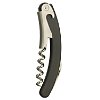I splashed out a week or two ago, and bought a Samsung NC10 netbook – a bargain at under £300, and it runs Windows 7 really well.
Impressed with the size and utility of the thing, I recalled a forerunner of the netbook, so went rooting around in my “box of old technology that it pretty much useless but cost money so I can’t ever throw it away”, in the loft.
I came across an old laptop that in its time was known as a “sub-notebook”: we got two of these machines courtesy of Sony, to demonstrate Exchange 2000, specifically the Conferencing Server version, at a big partner event in Birmingham. It was, to date, the biggest audience I’ve ever stood in front of, at about 1,400 people. I had a few minutes to demo the still-in-beta Exchange 2000, and would be doing it jointly with the host for the conference, Jonathan Ross (gulp).

Exchange 2000 Conferencing Server – aka “Jasper”
I’m now struggling to remember when this was, but since Exchange 2000 released in November 2000 (as discovered by the very useful Microsoft Support Lifecycle page), I reckon it must have been early/mid-2000, which would mean the little Vaio has to be at least 8 or 9 years old.
Sony Vaio PCG-C1XN
The two Vaios we had were great – well, great for the time anyway, although even then they were very functionally compromised even when new. The one thing you could say about the machine was it was small, and cool.
 Certainly not fast – a 266MHz Celeron CPU (a cut down Pentium II, in essence, for our younger readers), 64Mb of RAM and a 6.4Gb hard disk.
Certainly not fast – a 266MHz Celeron CPU (a cut down Pentium II, in essence, for our younger readers), 64Mb of RAM and a 6.4Gb hard disk.
The machines originally came with Windows 98, but we decided to put Windows 2000 on them for the demo; subsequently, I upgraded it to Windows XP and it’s probably a bit too much for the little mite. Suffice to say, it won’t be getting any further along the Windows evolutionary scale.
Other features of note were the webcam (one of – if not the – first laptops to come with one built in, which was the reason we wanted them for the Conferencing demo). A single USB port, FireWire (or iLink as Sony insisted on calling it), a PCMCIA slot, infra-red (you don’t get that any more now, do you?) and a dongle which had composite-video and VGA, complete the mix.
So for our demo we had to install an early Wifi network (it might have been the very first 802.11b from Compaq, costing hundreds of pounds for the router and at least £100 per PCMCIA card). All of this for 8 minutes of Woss-y glory, swept away in the sands of time.
Sony never did ask for it back – I hung onto one, and Steve kept the other. I bet he’s still got it somewhere too.
Dust the old girl off
Enough of this misty eyed nonsense. Amazingly, on plugging the machine in and powering up (apart from my going into the BIOS and setting the clock), it started to resume from hibernate – and dropped me back into the logon prompt for WinXP. I had some head scratching to do, to remember the password – but when I logged in, it was the first time for 6 years and 3 months.
Surprisingly, the Vaio is about the same thickness as my Samsung, so it doesn’t look quite as archaic as you might expect a 9-year old laptop to.
 It could even be called a “Netbook”, except there’s no networking on the thing – certainly no wireless, and even dial-up would have required an old modem like the Xircom PCMCIA card I literally just found in my office drawer.
It could even be called a “Netbook”, except there’s no networking on the thing – certainly no wireless, and even dial-up would have required an old modem like the Xircom PCMCIA card I literally just found in my office drawer.
Probably the biggest difference is the price when new. Adjusting for inflation and taking into account what the Vaio would have originally cost, it’s probably nearer £3,000 than the £300 for my NC10.
That’s Moore’s law for ya.






